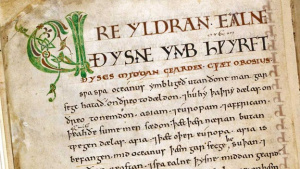Language/Old-english-ca-450-1100/Vocabulary/Colors
Hi Old English (ca. 450-1100) learners! 😊
In this lesson, we will explore the vocabulary related to colors in Old English (ca. 450-1100) while learning about the cultural significance of these colors. We will also provide examples in context for better understanding. Don't forget to check out the Find native speakers and ask them any questions you have on Polyglot Club to improve your learning experience!
Colors in Old English[edit | edit source]
Let's begin by learning the Old English (ca. 450-1100) words for colors!🎨
| Old English (ca. 450-1100) | Pronunciation | English |
|---|---|---|
| blæc | /blæθ/ | black |
| rēad | /ræːɑd/ | red |
| sweart | /sweːɑrt/ | dark/black |
| hwīt | /hwiːt/ | white |
| geolwe | /jeɑlwe/ | yellow |
| grēne | /ɡreːnə/ | green |
As you can see, some of these colors are still used today, while others, such as 'blæc', are not as common in modern-day English. In Old English (ca. 450-1100) culture, colors held great significance and were often used to symbolize different aspects of life, such as social status, religious beliefs, or even emotions.
Cultural Significance of Colors[edit | edit source]
Let's explore the cultural significance of each color in Old English (ca. 450-1100) society! 🏰
Blæc[edit | edit source]
'Blæc' was a color that represented death, evil, and mourning. It was often associated with the devil and was considered an unlucky color. In contrast, the modern-day association of black with elegance and sophistication did not exist in Old English (ca. 450-1100) culture.
Hwīt[edit | edit source]
'Hwīt' was a color that symbolized purity, innocence, and divinity. It represented goodness and was often associated with angels and saints. It was even used in Christian baptism as a sign of cleansing from sin.
Rēad[edit | edit source]
'Rēad' represented love, passion, and desire. It was also the color of blood and therefore symbolized sacrifice and martyrdom.
Sweart[edit | edit source]
'Sweart' was another word that meant 'black' but was often used to describe dark or intense emotions, such as anger or sadness.
Geolwe[edit | edit source]
'Geolwe' symbolized both joy and jealousy. It was often used to describe the golden color of the sun and was associated with the warmth and light it provided.
Grēne[edit | edit source]
'Grēne' symbolized growth, rebirth, and fertility. It was the color of nature and all things living. It was also associated with the Virgin Mary and her association with new life and growth.
Examples in Context[edit | edit source]
Dialogue:
- Person 1: Hwīt heofon. (White heaven.)
- Person 2: Hwæt sceal þæt betþȳn̄an? (What should that signify?)
- Person 1: Þæt heofonlic wuldor is clǣne ond pur. (That heavenly glory is clean and pure.)
In the above dialogue, 'hwīt' is used to describe the purity and cleanness of the heavenly glory.
Dialogue:
- Person 1: Þæt folc wearð onblāwend mīd rēades hige. (The people became inflamed with red passion.)
- Person 2: Hwǣt ārīs þæt hig mid þæs cynnes hige? (What caused them to have such passion?)
- Person 1: Hīe woldon heora lond gescyldan wið ðæs eorles eft-cyme. (They wanted to protect their land against the earl's return.)
In the above dialogue, 'rēad' is used to describe the passion and intensity of the people's desire to protect their land.
Conclusion[edit | edit source]
You have learned the Old English (ca. 450-1100) vocabulary related to colors and their cultural significance in Old English (ca. 450-1100) society. To improve your Old English (ca. 450-1100) Vocabulary, try using the vocabulary in your own sentences or dialogues. We hope you found this lesson interesting and insightful! 😀
➡ If you have any questions, please ask them in the comments section below.
➡ Feel free to edit this wiki page if you think it can be improved. 😎
Upon wrapping up this lesson, take a look at these related pages: Fruits, Clothes, Animals & Drinks.
Other Lessons[edit | edit source]
- How to Say Hello and Greetings
- Education
- Express Surprise
- How to say Good Bye?
- Feelings and Emotions
- Geography
- Drinks
- Count to 10
- Family
- Food

